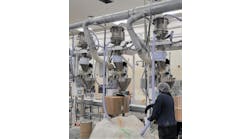Pneumatic conveying is one of the most versatile ways to move solids over moderate to long distances with minimum human power. Over the years, Chemical Processing has published several articles on the design, installation and operation of dense- and dilute-phase pneumatic conveyors along with several tips on how to plan a new system or modify an existing one (see: “Install Pneumatic Conveyors Correctly"). Attrition and erosion have become more of a factor in design and selection of pneumatic conveying systems, especially for ones involving products your company sends to customers. One of the most important parts of putting in a new conveying line is correct testing — particularly when the line involves a new product or long layout.
In the interest of making a sale, most vendors will perform a test at a nominal fee that seldom covers its real cost. Remember, they are not clairvoyant and usually don’t understand your overall processes as well as you do. Therefore, you must guide them through your concerns. In addition, understand that most of these test setups are not research systems but instead consist of demonstration devices. You should come to the test with a test plan agreed upon by you and the manufacturer. This may mean bringing in additional testing resources at your cost to supplement what is provided.
I suggest the test plan explore at least seven specific items. Some facilities may not be able to accommodate all of them but they certainly are worth discussing with your chosen shop. If you have access to some models, bring these and simulate the layout you are testing. This will prove useful when laying out your facility because you may detect problems in your proposed layout that won’t show up in the manufacturer’s demonstration facility.
Now, let’s look at the seven key items to check:
1. Particle attrition. This is the first and often the most important aspect of the test plan. Do particle-sizing tests at various conditions described below and look at the particles under a microscope. Another technique is to use the amount collected in the pan of a screening test or the amount blown over in an air-classifier.
2. Choking and saltation velocities. Attempt to find these and compare the values you get to calculated ones. Design your dilute-phase system at 1.5 times the maximum value — but plan to reduce this velocity after installation by decreasing the blower flow rate. Getting a manufacturer to agree to test for these velocities can be difficult because the system may plug up. One way to avoid plugging is to watch for pressure pulsations in the system that show the velocity is close to these limiting values.
3. Design velocity. Even in the absence of a modeling program, the manufacturer probably will have some suggestions for the correct design velocity. Most vendors like to evaluate a material prior to any test and will have recommendations. Run at both twice and half of the expected design velocity to evaluate stability and attrition.
4. Required emptying velocity. In dense-phase systems, it’s important to know what velocity is needed to completely empty the convey line and what effect this may have on attrition.
5. Velocity along the line. Calculating this requires pressure and temperature along the line. Most test systems I’ve worked with don’t have this information but it never hurts to ask for it.
6. Similarity of layout to planned system. While not always feasible, try to get the layout close to what is expected in the plant (elbows and lift location). On long complicated layouts, it may be possible to run two tests — with the velocity at the end of the first used as the starting velocity of the second layout.
7. Impact of power failure. Deliberately stop the gas flow and let the line sit overnight, if possible. Failures happen. The best place to find out the consequences is in the testing lab not the plant.
Make sure the solids-to-air ratio is constant during the test, especially for dilute-phase systems. The pressure also should not vary.
While the manufacturer will provide measurements of the operating parameters, you may find it educational and useful to your understanding of the process to do some of your own measurements. This not only can help you but also keeps the supplier on its toes.


